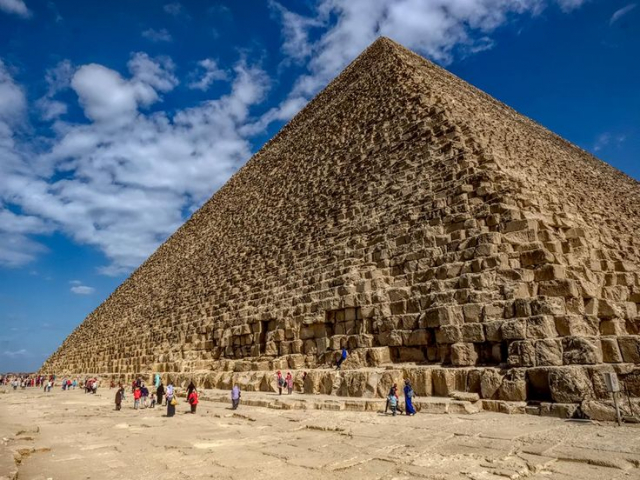Taj Mahal (India)
The Taj Mahal architectural complex is located in Agra, India, on the banks of the Yamuna River. This unique structure is over 370 years old. Construction began in 1632 and was completed in 1653. The height of the main mausoleum, surrounded by the vast complex, is 73 meters. As one of the most magnificent monuments of Mughal architecture, the Taj Mahal stands as a symbol of beauty and love. Emperor Shah Jahan built it for his beloved wife, Mumtaz Mahal. Millions of tourists visit this site annually. Its symmetrical design, exquisite marble finish, and beautiful gardens make it one of the New Seven Wonders of the World. The Taj Mahal is a significant UNESCO World Heritage Site with immense cultural and historical importance.
Great Wall of China (China)
The Great Wall of China stretches over 21,000 km from east to west across northern China. Construction began over 2,000 years ago, in the 7th century BCE. Several Chinese imperial dynasties contributed to its maintenance and expansion. It is a collection of fortifications built during various periods. The wall’s width ranges from 4.5 to 9 meters, and its height reaches 7.5 meters. Throughout history, the Great Wall served different purposes, primarily to protect against invasions. It also facilitated border control and trade regulation while showcasing the strength of Chinese civilization. As a representation of China’s rich history and architectural prowess, the Great Wall is both a UNESCO World Heritage Site and one of the New Seven Wonders of the World.
Petra (Jordan)
Petra, the rock city, is located in southern Jordan, in the Middle East. It sits in a basin surrounded by mountains that form Wadi Araba, a vast valley stretching from the Dead Sea to the Gulf of Aqaba. Scholars estimate Petra was founded in 312 BCE, reaching its peak in the 1st century CE during the Nabataean Kingdom. The city's history spans over 2,000 years, and its total area covers 264 square kilometers. Most of Petra’s buildings, including the Treasury and the Monastery, are in the city center. This incredible city, carved into the rocks, is an architectural wonder. In ancient times, it was a major trade hub frequented by merchants from the Arabian Peninsula, Egypt, and the Mediterranean. Now being a UNESCO World Heritage Site and one of the New Seven Wonders of the World, Petra captivates tourists with its stunning landscapes and intrigues scholars with its rich history.
Machu Picchu (Peru)
The Machu Picchu architectural complex is located in the Peruvian Andes, South America, at an altitude of 2,430 meters above sea level. Built in the 1450s by Inca ruler Pachacuti, this 600-year-old site features temples, terraces, and residential areas spread across approximately 3,000 square meters of archaeological excavations. Machu Picchu is renowned for its architectural sophistication, which remains largely intact, demonstrating the advanced skills of the Inca civilization. It was a center of astronomy, politics, and religion. As one of the New Seven Wonders of the World and a UNESCO World Heritage Site, Machu Picchu attracts millions of tourists each year.
Colosseum (Italy)
The Italian Colosseum, also known as the Flavian Amphitheatre, is located in the heart of Rome, east of the Roman Forum and near Palatine Hill. Built under the Flavian dynasty, construction took place between 70–72 CE and was completed by 80–82 CE, making the Colosseum nearly 1,900 years old. This massive structure stands 48 meters tall, with a circular arena measuring 189 meters in length and 156 meters in width. It could hold between 50,000 and 80,000 spectators. In ancient times, the Colosseum hosted various public events, gladiator contests, and even naval battle reenactments. It is a testament to innovative Roman engineering and architecture and symbolizes the grandeur and power of Ancient Rome. Today, the Colosseum is a UNESCO World Heritage Site and a unique tourist attraction.
Rio de Janeiro (Brazil)
The city of Rio de Janeiro is located on the Atlantic coast in southeastern Brazil. Founded by Portuguese explorers on March 1, 1565, it has a rich history spanning over 450 years. Today, Rio de Janeiro has a population of 6 million, making it Brazil's second-largest city after São Paulo. Each year, it hosts a world-famous carnival. The city is recognized as a UNESCO World Heritage Site due to its iconic landmarks, including the Christ the Redeemer statue, Sugarloaf Mountain, and Copacabana Beach. Rio de Janeiro is a major tourist destination, attracting visitors from all over the world with its unique culture and annual carnival.
Great Pyramid of Giza (Egypt)
The Great Pyramid of Giza, located on the Giza Plateau near Cairo, Egypt, was built between 2580 and 2560 BCE during the reign of Pharaoh Khufu. This structure is over 4,500 years old. Its current height is 138.8 meters, although it originally stood at 146.6 meters. The loss of the outer casing stones caused the pyramid’s slight decrease in height. Each side of its base measures 230.4 meters. The Great Pyramid is a testament to advanced engineering and architectural design. It was one of the Seven Wonders of the Ancient World and served as the tomb of Pharaoh Khufu. Now being a UNESCO World Heritage Site, the Great Pyramid continues to intrigue experts. Its precise alignment with the cardinal points and its mathematically refined construction remain subjects of fascination for scholars.
-
Grand Choice
Contest by
InstaForexInstaForex always strives to help you
fulfill your biggest dreams.JOIN CONTEST -
Chancy DepositDeposit your account with $3,000 and get $6000 more!
In December we raffle $6000 within the Chancy Deposit campaign!
Get a chance to win by depositing $3,000 to a trading account. Having fulfilled this condition, you become a campaign participant.JOIN CONTEST -
Trade Wise, Win DeviceTop up your account with at least $500, sign up for the contest, and get a chance to win mobile devices.JOIN CONTEST







 451
451 7
7









